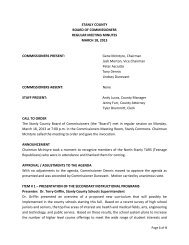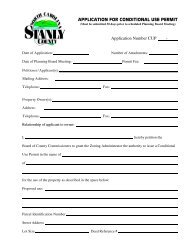Land Use Plan – 2002 - Stanly County, North Carolina
Land Use Plan – 2002 - Stanly County, North Carolina
Land Use Plan – 2002 - Stanly County, North Carolina
Create successful ePaper yourself
Turn your PDF publications into a flip-book with our unique Google optimized e-Paper software.
Weaknesses<br />
STANLY COUNTY<br />
Weaknesses of the TND model include the following:<br />
Requires adoption of several planning and implementation policies such as a land use plan,<br />
design guidelines and transfer of development rights to properly implement the concept.<br />
Requires political will and private sector support to draft, adopt, and implement each policy<br />
striving towards this development pattern.<br />
Although used throughout the U.S., TND is still relatively unfamiliar to developers, lending<br />
institutions, and other professions and institutions associated with the land development<br />
process.<br />
Figures 6-7 and 6-8 provide an illustration of the TND model.<br />
Cost of Community Services<br />
How It Works<br />
Cost of community services (COCS) is the analysis of the revenues generated and costs to a<br />
municipality, county, or other political jurisdiction associated with the provision of community<br />
services to various forms of development. Different types of development, for example, office,<br />
residential, industrial, or public uses generate differing levels of revenue (income, sales or<br />
property taxes) for the local community and each land use has different needs as far as services<br />
required (public safety, education, roads etc.) by that particular land use. This type of study<br />
outlines the differences in revenue and cost of services by land use category. COCS can be<br />
used as a means to evaluate the practicality of land use strategies such as the conversion of<br />
farmland to a residential subdivision. It can also be used as a means to justify the imposition of<br />
impact fees associated with development.<br />
COCS was developed by the American Farmland Trust (AFT), a non-profit organization devoted<br />
to the protection of farmland resources throughout the U.S. The first COCS study was<br />
completed by AFT for Madison Township, Ohio, a township located at the eastern edge of the<br />
growing Greater Cleveland metropolitan area in the early 1990s.<br />
COCS as practiced by AFT involves the following steps:<br />
1. Identifying and defining the appropriate land use categories such as residential, office,<br />
commercial, industrial, and agricultural uses.<br />
2. Collecting relevant financial data on revenues (tax receipts, local receipts) and expenditures<br />
(public safety, health and human services, public works, education, government).<br />
3. The results of this type of analysis generally show the following:<br />
For every $1.00 of revenue generated by residential uses the cost of services is $1.10 to<br />
$1.60.<br />
For every $1.00 of revenue generated by commercial uses, the cost of services is $0.20<br />
to $0.30.<br />
For every $1.00 of revenue generated by farms/forest uses the cost of services is $0.15<br />
to $0.40.<br />
<strong>Land</strong> <strong>Use</strong> <strong>Plan</strong> 6-25 6/02






